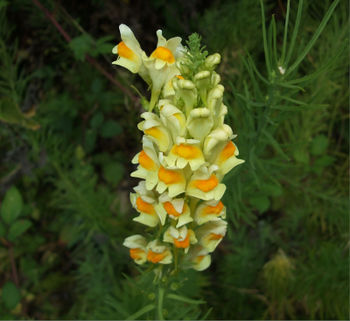Common Toadflax
Other Names : Linaria vulgaris, Brideweed, Butter and Eggs, Buttered Hayhocks, Calves' Snout, Churnstaff, Devil's Head, Devil's Ribbon, Doggies, Dragon-Bushes, Eggs and Bacon, Eggs and Collops, Flaxweed, Fluelli, Gallwort, Gueule-de-Lion, Larkspur Lion's Mouth, Linaire Commune, Linaire Sauvage, Linaire Vulgaire, Linaria, Linaria vulgaris, Monkey Flower, Muflier Sauvage, Pattens and Clogs, Pedlar's Basket, Pennywort, Rabbits, Ramsted, Toadpipe, Wild Snapdragon, Yellow Rod
Linaria vulgaris is a herbaceous, perennial plant growing from 25 to 60cm, with smooth, linear leaves and yellow, hermaphrodite flowers with orange top. The flowering and the harvesting take place from July to September.
Special Precautions of Common Toadflax
- Toadflax abounds in an acrid oil, reputed to be poisonous, but no harm from it has ever been recorded. Little or nothing is known of its toxic principle, but its use in medicine was well known to the ancients.
- Plant's consumption must be avoided during pregnancy.
Active substances
Its constituents are stated to be two glucosides, Linarin and Pectolinarian, with linarosin, linaracin, antirrhinic, tannic and citric acids, iron, magnesium, calcium, mucus, essential oil, a yellow colouring matter, mucilage and sugar.
Health Benefits and Uses of Common Toadflax
- Linaria vulgaris has a long history of use in herbal remedies for a wide variety of ailments including jaundice, dropsy and enteritis.
- Astringent, hepatic and detergent. It has some powerful qualities as a purgative and diuretic, causing it to be recommended in jaundice, liver, skin diseases and scrofula; an infusion of 1 OZ. to the pint has been found serviceable as an alterative in these cases and in incipient dropsy. The infusion has a bitter and unpleasant taste, occasioned by the presence of the acrid essential oil. It was at one time in great reputation among herb doctors for dropsy. The herb distilled answers the same purpose, as a decoction of both leaves and flowers in removing obstructions of the liver. It is very effectual if a little Peruvian bark or solution of quinine and a little cinnamon be combined with it. Gerard informs us that 'the decoction openeth the stopping of the liver and spleen, and is singular good against the jaundice which is of long continuance,' and further states that 'a decoction of Toadflax taketh away the yellownesse and deformitie of the skinne, being washed and bathed therewith.'
- A laxative tea used to be made from the leaves of Common Toadflax, which was also the basis of ointments for various skin diseases and for treating piles.
- The herbal tea is administered as astringent, laxative, diuretic, hepatic and antidiarrheal. *It is recommended for the treatment of edema, cystitis, jaundice, liver and gallbladder diseases.
- The fresh plant is sometimes applied as a poultice or fomentation to haemorrhoids, and an ointment of the flowers has been employed for the same purpose, and also locally in diseases of the skin. A cooling ointment is made from the fresh plant - the whole herb is chopped and boiled in lard till crisp, then strained. The result is a fine green ointment, a good application for piles, sores, ulcers and skin eruptions. It is applied externally to the skin in the form of poultice against various skin diseases such as rashes, ulcers, inflammation, wounds and hemorrhoids.
- The juice of the herb, or the distilled water, has been considered a good remedy for inflammation of the eyes, and for cleansing ulcerous sores.
- Boiled in milk, the plant is said to yield an excellent fly poison, and it is an old country custom in parts of Sweden to infuse Toadflax flowers in milk, and stand the infusion about where flies are troublesome.
- The flowers have been employed in Germany as a yellow dye.
- Other recorded uses include the production of insecticides, which may seem rather odd because bees and other nectar-hunting insects seem to love the flowers of Common Toadflax.
